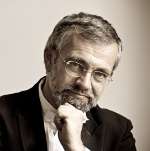One could hardly dream of a better concert to open the official season of the Sydney Symphony Orchestra with Chief Conductor David Robertson at the helm, than one featuring Maxim Vengerov as the guest soloist in Johannes Brahms' Violin Concerto in D major. The composition of this work was greatly influenced by the close personal relationship and professional advice of the outstanding Hungarian violinist, Joseph Joachim. Some violinists probably regret this; even the famous virtuoso Henryk Wieniawski called it outright ‘unplayable’.
The extreme technical difficulties of the piece may be in part due to Joachim’s famously large hands, which inspired the composer to write several strenuous stretches for the left hand. At the same time, showy virtuoso athletics – both common and expected in 19th-century concertos – are almost completely absent from this work. Unusually, the solo part repeatedly includes intricate accompanying figures, rather than the main theme, nowhere as much as in the slow movement, where the composer offered the haunting theme to the first oboe and later to the orchestra, but never to the soloist.
Such a work suits Vengerov’s artistic personality to a tee. He does not seem to care much about flashy fireworks, notwithstanding the fact that he is more than capable of performing them. While the Brahms Concerto is often presented as a fierce effort to conquer its relentless contrapuntal challenges and technical difficulties, Vengerov’s artistic attitude is unassuming, rather than fierce. He exerts no visible effort, but gives the listener a highly personal reading of what the work means to him. Bar after bar, he presents the unfolding melodies with the elated, almost naive pleasure of a child opening his Christmas presents.
His flawless bowing guarantees the immaculate connection between notes, bars and phrases; it also makes the softest pianissimos ring out clearly and articulately. This caused an occasional lack of balance, as the accompanying orchestra was not always able to remain on par with that sound quality on several occasions. The problem, at least in part, could have been solved by simply using a smaller orchestra. Arguably, 24 violins (and matching numbers in the other string sections) is too large a group to effectively emulate the variety of dynamics that an artist of Vengerov’s magnitude employs, without concessions to orchestral sonorities.
When it was the soloist’s turn to accompany the orchestral melodies, for example, in the extended triplet passages of the first movement, Vengerov never lost control of the flow of his finely shaped line and clearly remained part of the musical structure without ever overstating his role. Melancholy and autumnal feelings characterised his contribution to the second movement and the last movement’s mood was appropriately playful (Allegro giocoso, says the tempo instruction) rather than heroic, as it is sometimes performed.
One of the most attractive characteristics of Vengerov’s playing is his impeccable way of playing double stops and full chords; the smoothness of his parallel thirds, sixths and octaves (and even the occasional third on top of an octave, a tenth) surpasses many a lesser player’s single melody lines.
On his last appearance in the Concert Hall of the Opera House, barely fourteen months ago, Vengerov performed the Chaconne from Bach’s Partita in D minor. This time he chose the Sarabande from the same work, as an encore. Hopefully it won’t be long before the Sydney audience will have a chance to hear the remaining three movements.
After the interval, the SSO presented another Romantic masterpiece (composed barely ten years after the Brahms concerto), Pyotr Ilyich Tchaikovsky’s ever conquering Symphony no. 5 in E minor. After the autumnal atmosphere of the Brahms, the Russian master’s music felt positively wintery at times. The challenge of such a popular work is how to keep it fresh and exciting, and this closely relates to the multilayered transformations of the opening motif. At its first appearance, it may sound broodingly subdued but this changes later as it reappears in the following movements in different disguises. The dark and sombre atmosphere of this idée fixe at the beginning of the first movement becomes pompous and gargantuan in the middle of the slow movement, positively menacing at the end of the Valse, only to ultimately turn into an exhilarating march in the climatic last movement.
Conductor and orchestra were united in building up a splendid edifice of contrasting themes, moods and forms. The large string body was truly justified here and sounded majestic yet warm in the great unison melodies while equally impressive in the quiet moments, for example, in the introduction of the slow movement. The many instrumental solos by horns, clarinets, oboes and others brought out the intimacy of those themes eloquently, contrasted in perfect proportion with the shine of splendid brass sounds in the large orchestral tuttis.


